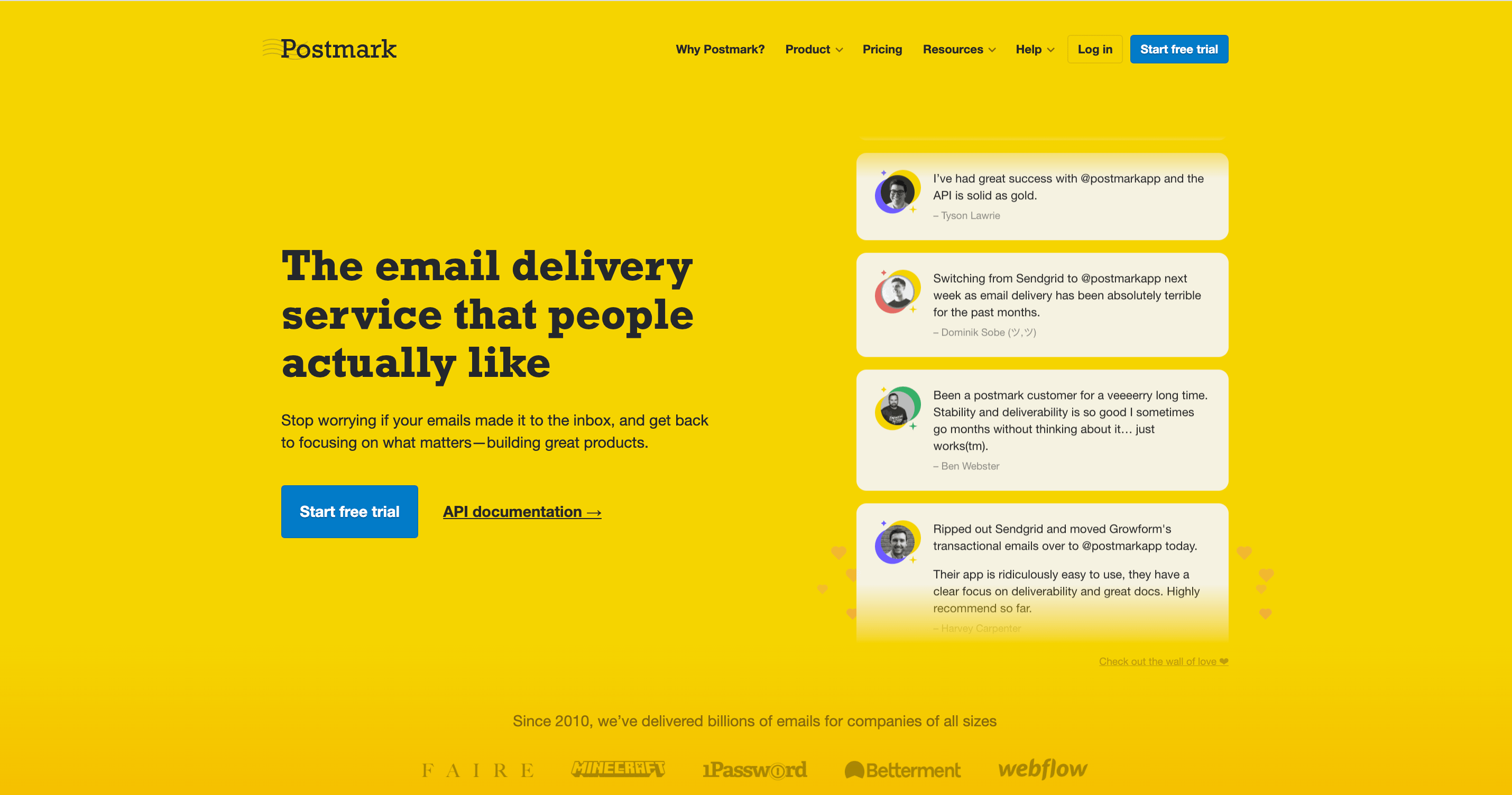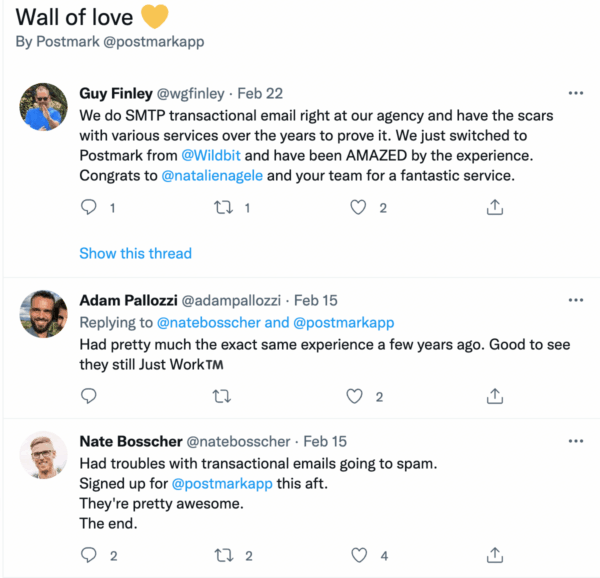Developer favorites: the 5 best email APIs in 2025
If you’re looking for an API to integrate email functionality into your app or product, you’ve got a bunch of email API providers to choose from. But which ones are worth looking into? We’ve written in detail about the factors you should consider when evaluating email APIs, so here we’ll be looking at how the most popular email API vendors compare to help narrow down your search.
Need a quick email API refresher?
What’s an email API—and when should you use an API vs. SMTP? For an introduction to email APIs and popular use cases, check out our 101 of email APIs.
Comparison sheet: The best email APIs in 2025 side by side #
For those of you who just need a quick comparison of the best and most popular email API services and their pricing side by side, we’ve put together this handy spreadsheet. Feel free to make a copy, edit it as you please to make it your own, and share it with your team (or your boss.)
Now, let’s dig into the top providers one by one.
1. Postmark
#

🤓 Quick access: Browse Postmark’s API documentation or check out the API Explorer
We know people always say “don’t set it and forget it!” but you know what: Here at Postmark, we strive to help you do just that with your email integration. The team at Postmark built an email API that’s easy to integrate and once it’s set up, you can count on Postmark to deliver your emails fast and reliably—so you don’t have to worry about deliverability issues and can go back to building great products.
Postmark’s API is easy to use and offers a comprehensive feature set, from sending emails and retrieving stats and bounce insights to processing inbound email. Pair that with great documentation, reliable deliverability thanks to rigid a no-spam policy and the separation of promotional and transactional email, and truly knowledgable customer support, and you’ve got an email API service that has grown to become a developer favorite:
Postmark maintains the following official libraries:
Rails
Ruby
.NET
Java
PHP
Node.js
You can find more community libraries here.
Pricing #
Postmark uses volume-based pricing, where how much you pay depends entirely on how many emails you send. No feature gates or paywalls: You get to use all of Postmark’s API features, no matter what plan you’re on.
Cost to send 10,000 emails: $15 per month
Cost to send 300,000 emails: $245 per month
Cost to send 1 million emails: $695 per month
2. SendGrid #
🤓 Quick access: Sendgrid’s developer documentation
Founded in 2009, SendGrid is one of the oldest players in the email API space, and many developers rely on SendGrid to integrate email functionalities into their apps. Today, SendGrid offers much more than just an API: as part of the Twilio ecosystem, SendGrid provides a broad range of email marketing and customer engagement services.
Fans of SendGrid appreciate the all-in-one platform that provides an email API alongside other email marketing and SMS solutions, but there are also voices that complain that the quality of customer service has decreased since the Twilio acquisition; on top of that, some Sendgrid customers report that they see mixed email delivery results on Sendgrid’s shared IPs.
Switching to a dedicated IP can help, but those are only included in the more expensive Pro plan and above. Plus, we think selling dedicated IPs as a silver bullet to fix deliverability issues is a questionable move.
SendGrid’s API offers the broad range of features you’d expect from a well-established email API, and their documentation is comprehensive and solid. Sendgrid maintains official libraries for the following languages:
C#
Go
Java
NodeJS
PHP
Python
Ruby
Pricing #
SendGrid offers multiple pricing tiers covering different email volumes and features, so review their plans carefully to find the one that’s right for you.
Cost to send 10,000 emails: $19.95 per month (Essentials plan)
Cost to send 300,000 emails: $249 per month (Pro plan)
Cost to send 1 million emails: $602 per month (Pro 700k plan + overages)
3. SparkPost #
🤓 Quick access: SparkPost’s developer documentation
SparkPost is a delivery service that handles massive amounts of email: the team claims to deliver about 4-5 trillion sends every year, nearly 40% of all B2C and B2B email. That’s a lot of emails.
It’s clear that the folks at SparkPost have set their focus on the enterprise market: Reliable high-volume sending, premium technical support on Enterprise plans, and a focus on security and compliance make SparkPost a popular choice for Enterprise customers. For startups or senders with moderate email volumes, however, SparkPost might be overkill.
SparkPost offers a comprehensive set of features, including email sending, validation, and analytics, all of which are well-documented and available via their API.
They offer client libraries in the following languages:
Elixir
Go
Java
Node
NodeMailer
PHP
Python
Pricing #
SparkPost offers three service tiers: Starter, Premier, and Enterprise—all covering different email volumes and features. Inbound processing and dedicated sending IPs, for example, aren’t available on the Starter plan.
Cost to send 10,000 emails: $20 per month (Starter)
Cost to send 300,000 emails: $205 per month (Premier plan + overage fees)
Cost to send 1 million emails: $525 per month (Premier)
4. Mailgun #
🤓 Quick access: Mailgun’s API documentation
“A powerful API that enables you to send, receive and track email effortlessly”—that’s how Mailgun summarizes its service on the homepage. Mailgun’s API is powerful and flexible and allows developers to send emails, manage mailing lists and suppressions, and retrieve stats.
Mailgun’s API docs are comprehensive but have received mixed reviews in the past, and it’s worth pointing out that Mailgun maintains fewer official libraries than other API providers on this list:
PHP
Ruby
Go
Node.js
The folks at Mailgun have gone through a bunch of acquisitions over the past years: They got acquired by Pathwire at the beginning of 2021, which in turn got acquired by Sinch later that year. Now, Mailgun is part of a larger family of messaging services, but it’s still available as a standalone product that’s focused on catering to developers.
Pricing #
For higher email volumes, Mailgun is more on the pricey side. Plus, be aware that not all of Mailgun’s features are available on all plans. So compare carefully to find the plan that’s right for your needs.
Cost to send 10,000 emails: $35 per month (Foundation)
Cost to send 300,000 emails: $255 per month (Scale + overages)
Cost to send 1 million emails: $700 per month (Scale)
5. Amazon SES #
🤓 Quick access: Amazon SES API documentation
If price is a major consideration for your email API selection process, you’ll want to look at Amazon SES: it’s by far the cheapest email API service on the market. But in exchange for the bargain price, you have to be okay with a stripped-down service with limited features: SES doesn’t handle bounces, there are no analytics and deliverability insights available, and customer support is only available to customers with dedicated support plans. Plus, the email API documentation is limited and not always easy to follow, and as a result, many developers find integrating with Amazon SES cumbersome.
.NET
Java
PHP
Ruby
Python
Pricing #
Pricing for Amazon SES is far cheaper than anything else in this review, but that’s in exchange for a limited feature set.
Cost to send 10,000 emails: $1 per month
Cost to send 300,000 emails: $30 per month
Cost to send 1 million emails: $100 per month
Note that if you’re already an Amazon EC2 user, you get 62,000 free emails per month through the API.
Postmark: The email API that developers actually love
Easy integration, reliable delivery, and great documentation are just a few of the reasons why developers love Postmark’s email API. Try it yourself and start sending in minutes.
PS: if you want to know how these providers compare to one another when it comes to additional services, we've got you covered with this list of the best transactional email providers and best email SMTP services in 2023.




